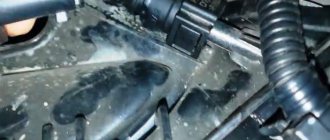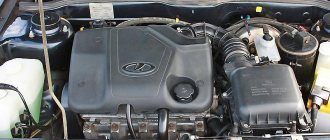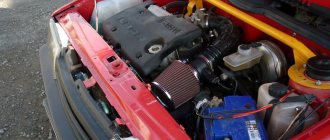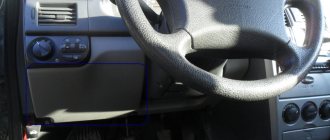Lada Vesta is equipped with one of two gasoline engines – 21129 (1.6 l.) or 21127 (1.8 l.). The control system is electronic. Initially, the operation of the computer and feedback sensors is finely tuned. However, over time, a problem arises - instability of speed at idle and while driving. Determining the exact cause is often difficult due to the fact that the Check Engine light does not light up, so scanning the ECU is useless. Still, you can identify the flaw of uncomfortable functioning on your own.
The theory of engine vibration at idle speed of Lada Vesta and possible causes
Theoretical aspects
The amount of air is regulated: the degree to which the gas pedal is pressed determines the opening angle of the throttle valve. Incorrect determination of the control system for the volume of the air mixture leads to the fact that the speed of the Lada Vesta floats at idle and while driving.
What causes the floating effect? The amount of gasoline sprayed into the manifold is calculated based on the volume of incoming air. When the computer perceives the latter incorrectly, the motor gains momentum. The degree of fuel injection remains the same, the mixture becomes leaner and the power plant begins to stall. The amount of oxygen and nitrogen mixture consumed is reduced, fuel consumption remains the same and is now sufficient - engine operation is stabilized. Then the cycle repeats.
Probable Causes
At this stage, it is clear that low-quality fuel can cause engine detonation, but not cause unstable idling. Untimely ignition of the fuel-air mixture can cause a negative effect. To eliminate the malfunction, a comprehensive inspection should be carried out:
- SU sensors.
- Regulator in the throttle assembly.
- Elements of the inlet assembly unit.
- Brake system units.
- Gasoline vapor recovery algorithm devices.
- Ignition systems.
Lada Vesta. INCREASED OIL CONSUMPTION (OVER 500 G PER 1000 KM)
| List of possible faults | Diagnostics | Elimination methods |
| Oil leakage through: crankshaft and camshaft oil seals; oil pan, cylinder head gaskets; oil pressure sensor; oil filter o-ring | Wash the engine, then after a short drive, inspect for possible leaks. | Tighten the fastening elements of the cylinder head, cylinder head cover, oil pan, replace worn oil seals and gaskets |
| Wear and loss of elasticity of oil seals (valve seals). Wear of valve stems, guide bushings | Inspection of parts when disassembling the engine | Replace worn parts |
| Wear, breakage or coking (loss of mobility) of the piston rings. Wear of pistons, cylinders | Inspection and measurement of parts after engine disassembly | Replace worn pistons and rings. Bore and hone the cylinders |
| Using oil of inappropriate viscosity | — | Change the oil |
| The crankcase ventilation system is clogged | Inspection | Clean the ventilation system |
content .. 1 2 3 5 ..
Route map for identifying causes
Incorrect determination by the computer of the volume of air supplied to the combustion chamber, problems with the ignition system and an additional flow of gasoline vapor into the intake manifold of the Lada Vesta cause engine vibration at idle speed and operating modes. There are many reasons, so diagnosis should be done progressively. Check:
- Presence of air leaks in the intake pipe.
- The operation of the vacuum brake booster and the integrity of the connection between the tube and the input manifold.
- Canister valve.
- Throttle position sensors, absolute pressure and temperature sensors, idle air control.
- Integrity of wires and serviceability of ignition system coils.
I started seeing this problem. Sometimes there is a failure in power, that is, at FIRST you can’t turn it on until it slips (even with ESP turned off!), but if you turn off the engine and start it again, there is a possibility that the dynamics will return, the problem is floating and I don’t understand at all what it depends on. upd: I'm inclined to think that the pedal is being naughty.
upd: The switched-on speed limiter is to blame, it chokes the engine throughout the entire speed range, turn it off and everything is fine!
In order for the car to comply with more stringent environmental standards, AvtoVAZ equips modern Lada cars (Priora, Granta, Kalina, Niva, Largus, Vesta and XRAY) with an electronic gas pedal or “E-gas”. The throttle valve drive got rid of the cable and became equipped with a gear motor. As a result, the gas pedal has no mechanical connection with the throttle valve, and engine control has become completely electronic.
Lada Vesta. POPING IN THE INLET PIPE
| List of possible faults | Diagnostics | Elimination methods |
| The clearances in the valve drive are not adjusted | Check valve clearances | Adjust the clearances in the valve drive |
| Intake valves sticking in the guide bushings: gum deposits on the surface of the valve stem or bushing, sediment or broken valve springs | Inspection during engine disassembly (STO) | Repair the engine (service station) |
| Disturbed valve timing | Check valve timing | Establish the correct relative position of the crankshaft and camshaft. Check compression |
Operating principle of the electronic pedal
A gearbox, an electric motor and two sensors are built into the throttle body. The electric motor turns the throttle valve through a gearbox, and its position is monitored by two sensors.
The electronic gas pedal is a plastic lever, and two sensors are installed in the bracket. All elements are a single structure (gas pedal module). The sensors are potentiometers, the moving contact of which is rigidly connected to the rotary axis of the pedal lever.
electronic gas pedal Lada Priora, Granta, Kalina, Vesta electronic gas pedal Lada Priora, Granta, Kalina
The electronic control unit (ECU) continuously monitors the pedal position based on sensor signals. Based on these parameters, the ECU sends control commands to the throttle gearbox and to the fuel injectors.
How to increase the pressure in the fuel system of Lada Vesta to normal
If we are sure that the injectors are working correctly and they are clean, and the fuel pump is able to create the necessary pressure, then all the blame for the current situation with failures and jerking lies only with the pressure regulator. Here he is.
The hero of today's celebration is the fuel pressure regulator (FPR).
There are two options - either replace the pressure regulator with a new one at 3.8 atm, or improve the old one at your own risk. Oddly enough, the last option gives the best results.
First, let's buy a new regulator and install it in place. This is done simply, but not too quickly ( we figured out how to remove the Lada Vesta fuel module here ):
If the replacement did not give anything (the pressure in the ramp did not increase, it remained at 3.50 atm), we will try to modernize the old regulator.
The regulator has a very simple design - it is a valve in a housing, loaded by a spring with a calculated force. The spring must create such a force that the valve opens no earlier than the electric fuel pump creates a pressure of 3.80 bar.
The force of the spring on the valve is regulated by the depth of the recess in the lower part of the regulator.
The depth of the standard recess is about 3 mm.
To increase the force (thereby forcing the valve to open a little later and provide higher pressure), it is enough to carefully shrink the central part of the bottom of the regulator body by a few millimeters.
To do this, we use available tools - a long bolt with a rounded end on sandpaper, a strong washer of suitable diameter, a vice and a hammer. As a rule, the recess depth of a standard regulator is no more than 3 mm.
We install the RTD on a vice through a spacer made of a washer and with a light, precise blow we seat the bottom a few more millimeters.
Ready. You can check the results of modifications to the fuel pressure regulator by measuring the pressure in the rail or simply by going for a test drive.
In most cases, such a modification eliminates jerks during acceleration, allows you to save a little fuel (this can be seen by the instantaneous consumption on the BC display) and solves the problem with failures in transient engine operating modes and in maximum power modes.
Source
Malfunctions of the electronic gas pedal
Moving contacts and conductive paths are subject to wear, which makes their signals incorrect. As a result, the engine will operate unstably, “dips” will appear, and at idle the speed will “float”. If a malfunction occurs in the operation of E-gas, the Check Engine warning lamp on the instrument panel will light up, and the ECU will switch the system to a reserve mode of operation, in which the speed will increase slowly, even when the gas pedal is pressed sharply. Fuel consumption may also increase.
If both sensors fail, the ECU will switch the engine management system to emergency operation mode, the engine will only operate at speeds slightly above idle (1500 min-1). In this case, it is recommended to contact a service station to replace the failed parts under warranty.
Lada Vesta. SILENCER SHOTS
| List of possible faults | Diagnostics | Elimination methods |
| The clearances in the valve drive are not adjusted | Check valve clearances | Adjust the clearances in the valve drive |
| Exhaust valves sticking in their bushings: increased valve stem or bushing wear, sediment or broken valve springs | Inspection during engine disassembly | Have the engine repaired at a service station |
| Disturbed valve timing | Check valve timing | Establish the correct relative position of the shafts. Check compression |
| Spark plugs are faulty: current leakage through cracks in the insulator or carbon deposits on the heat cone, poor contact of the central electrode | Spark plugs are checked at a special stand (STO). The absence of external damage and sparking between the electrodes on the inverted spark plug does not allow us to draw a conclusion about its functionality | Replace spark plugs |
| Damage to the insulation of high-voltage devices and circuits - interruptions in sparking | Using an ohmmeter, check for open or breakdown (short to ground) of the ignition coil windings and high-voltage wires | Replace the faulty ignition coil, damaged high-voltage wires (when disconnecting the wire, pull its tip). In severe operating conditions, it is advisable to replace the wires every 3–5 years |
| Faulty injectors | Check the operation of the injectors | Replace faulty injectors |
How to make the Lada go. We did chip tuning on Vesta SW Cross - and did not regret it
Even the most avid Lada Vesta fan has to admit: the dynamics of this model are so-so. Especially if we are talking about a heavier station wagon, and even in the Cross version with larger wheels. Therefore, the topic of chip tuning is popular among newsmakers. Well, we took the opportunity to talk with owners of cars with 1.6 and 1.8 engines with Russian Racing Technology firmware, and also tried them out!
We did it according to the logs, then to the stand
Let's start with the red one - Vesta SW Cross with a 1.6 engine and manual transmission. The car was purchased in the middle of this year, but has already covered more than 17,000 km. The last 2,000 km of them are after chip tuning.
“Why did the idea of flashing this car come up? In the summer, shortly after purchasing the Vesta Cross, my family and I went on a short trip with it. And then I caught myself thinking that in a well-loaded car - people in the cabin, things in the trunk - I simply cannot overtake a KamAZ uphill,” says the owner of the car. — I’m exaggerating, of course, but even on our “flat” Belarusian coaster there are already questions. I can’t imagine what it would be like on the Caucasian mountain roads. In general, with completely standard factory firmware, the car did not move under load.
This is how the idea came up to “flash” the car, fortunately there is a friend in Russia who does tuning and calibration. First we made a remote program and tested it. Then it was corrected more than once: either the car reacted too sharply to the pedal, it was impossible to drive it smoothly, or something else. Then Vladimir found time, flew to Minsk and already worked at the stand. Not with this particular car - he made a sedan, but with the same 1.6-liter engine."
And here’s how Vladimir himself describes this process on his social network page:
“Let’s sum up the results of the trip to Minsk. We managed to update the firmware for Lada Vesta and XRay with 1.6 engines, now our firmware has 115.3 hp. and 162.0 Nm. The firmware has passed all tests. It was rolled out to Minsk and tested in various modes and conditions by our representatives in Minsk and Krasnodar. I would like to thank my representative and colleague from Krasnodar Leonid for testing, searching and helping in eliminating problems of various transient modes and general behavior of the machine. After all the tests and rollbacks on the road, work began on the stand.
Upon arrival at the stand we had 111 hp. on the firmware, which was debugged on the road using logs. The work at the stand lasted about three hours, where the mixture was rolled out with the ShDC to the ideal in power mode, a lot of work was done with the ignition angle, and after 13-15 measurements we reached 115 hp. and 162 Nm. But it was too early to rush to conclusions; we decided to ride around 1000 km. The result after tuning at the stand on 10/06/2018: the car drove more than 1,200 km until 10/09/2018, a repeat measurement was made, where the numbers remained unchanged, which indicates that the torque model was correctly configured and that the solution can be used in series.”
"Spider" decides?
So, even with the preservation of Euro 5, the firmware made it possible to increase power to 115.2 hp and torque to 161.6 Nm. But the “red” Vesta Cross should, in theory, be even more powerful and faster. Due to what?
The standard catalytic collector gave way to a “spider” - an equal-length 4-2-1 collector, which made it easier for the engine to “breathe”. But the environment has fallen victim: now, having lost the catalyst, neutralizer and one of the oxygen sensors, instead of Euro-5, the car meets the requirements of only Euro-2 standards.
“All my previous Ladas had spiders,” says the owner. — I like it better: the feedback from the car is better, as is the dynamics. By the way, the equal-length manifold on the Vesta is installed differently than in older models. With “even” hands on a “nine” or “Kalina” this can be done in an hour, but on a “Vesta” it takes three hours at best, because you have to remove the subframe. And as luck would have it, I had to do this twice. After the first installation, a clearly audible ringing appeared in certain operating modes. The collector was thin-walled, apparently, a resonating sound arose. Therefore, I removed the “spider” and wrapped it with thermal tape. The ringing did not go away completely, but it became much quieter, almost twice as loud.”
How has the character of the car changed? The owner notes that fuel consumption remained at the same level, but the engine began to start better and run more fun: “The engine now starts with half a turn, like on the good old January 5.1.” With serial firmware, the engine takes longer to start. Dynamics? As for me, and I like to keep the engine at “working” speed, the car has become much more pleasant to drive. And the “working” speed is from 3 to 6 thousand. If I need to drive dynamically, I drive at 3500-6000 rpm. And the engine does not freeze. At the factory, the cutoff is already at six thousand, but here it spins up to seven thousand.”
True, the owner himself admits that he does not know where the merit of the firmware is and where the “spider” is, because after replacing the collector there was another adjustment to the program. And for the same reason, there are no exact figures for this configuration - we didn’t have time to take measurements on a dyno: “I have an idea to install a standard exhaust and “play” with the settings. After the latest firmware, and it was already done with the “spider”, I did not try it. You can install a standard exhaust and drive around with it.”
Well, for now let's see what this configuration gives. At walking speed, the car twitches a little and asks to increase the speed a little. And the very first acceleration makes it clear: the 1.6-liter 16-valve engine still requires that it be “twisted” for dynamic driving. Up to 3000 rpm, thrust remains quite modest, but then begins to increase - and so on until the red line at the tachometer, which starts at 6000 rpm.
Has the engine become more angry in sound, and more combative in character? One could say so, but on a heavy station wagon with large 17-inch wheels, he still spends all his added strength fighting inertia.
And it feels like it drives about the same as a lighter sedan on 15-inch wheels (I managed to drive one a few days later). If this is really the case, then not bad: according to the factory, the sedan accelerates from zero to 100 km/h in 11.2 seconds, the “raised” station wagon in 12.6.
Heaven and earth
By the way, according to the passport data, the Vesta SW Cross with a 1.8-liter engine (122 hp and 170 Nm) and “mechanics” goes the same 11.2 seconds to “hundreds”. But you know what? A week before, I had the opportunity to drive a test car in this configuration - and it didn’t seem particularly dynamic to me! Yes, yes, even despite the larger engine and the shorter (4.2 versus 3.9) main pair in the box, there is no need to talk about a more dynamic character.
Surprisingly, the presence of a phase shifter at the intake had no effect on the elasticity of the engine in the mid-speed zone: it seems that it is strongly “strangled” for the sake of the environment and does not want to pull until the tachometer needle exceeds 3000 rpm. But as soon as you drop it below 1500 rpm, you won’t be able to pull it out - the engine will start convulsing, as if you don’t have an injector with factory firmware, but a poorly tuned carburetor!
More recent Vestas with a 1.8-liter engine have received updated firmware in which these shortcomings are eliminated. If so, it would not interfere with early copies.
However, here is a gray car, purchased in the summer of 2022, it already has a new “square” ramp and what seems to be a new factory program. But even this car drove completely differently after reflashing!
“The engine starts better. There are no jerks between first and second gears, acceleration has become better, there is no such thoughtfulness when you press the pedal, and the car “thinks” for a second and a half and only then starts driving. You no longer need to turn the engine, it just goes on like that. Even if it’s in the wrong gear, instead of third, fourth, for example, it still accelerates willingly. You immediately feel that the car is driving and not “thinking,” says the owner of this car. — Consumption has even dropped. On the highway it doesn’t show more than 7 liters, that’s if you “press”, but it’s 6.5. I’ve never even seen such numbers on factory firmware before!”
The difference is really noticeable. Firstly, the “altered” engine pulls completely calmly at low speeds and does not think of convulsing, like the option with factory firmware. Secondly, it is really ready to pull from 2000 rpm, as a motor with a variable valve timing system should do! At low speeds this results in excellent responsiveness to the gas, at high speeds it simply results in more confident acceleration. You no longer have to “turn” the engine, squeezing all the juices out of it—it’s both quieter and more economical.
At the stand, this particular car showed 137.2 hp. and 182.1 Nm (however, even before the firmware on the same stand, the car produced 136.2 hp and 175.5 Nm, which is higher than the factory values). And now the owners are already discussing with me the prospects of installing, say, an intake from a 145-horsepower Vesta Sport. Something tells me that in a year or two many interesting technical solutions will appear for the 1.8-liter engine...
“If I were buying a car now, I would buy it with a 1.8 engine, I wouldn’t even think about it, despite all these “horror stories” about the oil burner. As a last resort, if anything happens, there is a guarantee,” notes the owner of a “red” car with a 1.6-liter engine.
“So I took the car in the summer, and a friend was at work at about the same time. I’m fine, his engine is burning oil,” answers the owner of a gray car with a 1.8 engine.
I'm wondering if they are afraid of losing the warranty if the "chip" is discovered.
“I went to the service center, they connected the scanner and didn’t notice anything,” says the owner of the gray car.
“A non-original collector is, of course, a reason to remove the car from warranty,” notes the owner of the “redhead.” - But the firmware is made in such a way that the dealer cannot find out whether the “chip” is made or not. This is simply a calibration of the standard electronic engine control unit. It is not possible to simply calculate it. Most likely, only if the block is removed and sent to the factory. If there are no problems in this regard, no one will ever do this and will never know anything.”
Our verdict
There are no miracles: without interfering with the hardware, you can’t squeeze much out of a naturally-aspirated engine through firmware alone. Nevertheless, in transitional modes the character of the engines has become more pleasant, this is especially noticeable in the 1.8-liter version, which, on the “alternative” firmware, is much more elastic in the low and medium speed zone. The 1.6-liter engine, although it has become subjectively “more fun,” still prefers to work at the “top”. As for replacing the standard catalytic collector with a “spider” one, taking into account the deterioration of environmental characteristics and acoustic comfort, this option is justified only in the case of building a serious tuning project or a sports car, where it is impossible to live without such a collector. But for everyday driving this is already too much.
| Factory data Lada Vesta SW Cross | |||
| Engine | 1.6-16v | 1.8-16v | |
| Working volume, cubic cm | 1596 | 1774 | |
| Power, kW (hp) at rpm | 78(106)/5800 | 90(122)/5900 | |
| Torque, Nm at rpm | 148/4200 | 170/3700 | |
| Transmission | 5M | 5M (5AMT) | |
| Acceleration 0-100 km/h, s | 12,6 | 11,2 (13,3) | |
| Maximum speed, km/h | 172 | 180 (181) | |
| Average fuel consumption, l | 7,5 | 7,9 (7,7) | |
| Dyno measurement results | ||||
| Engine | 1.6-16v | 1.6-16v (chip) | 1.8-16v | 1.8-16v (chip) |
| Power, kW (hp) at rpm | 79,1(107,7)/5931 | 84,7(115,2)/6256 | 100,1(136,2)/5901 | 100,8(137,2)/5979 |
| Torque, Nm at rpm | 145,2/4393 | 161,6/4098 | 175,5/4598 | 182,1/4581 |
Ivan KRISHKEVICH Photos of the author and car owners ABW.BY
More than 81,000 offers for the sale of new and used cars in our ad database.
Where do the savings come from?
A four-cylinder engine makes four strokes in one full cycle. On the first stroke, fuel is always supplied. A modified throttle makes the fuel mixture better. Due to which it burns better. Because of this, the engine torque increases. And the car becomes more dynamic at low speeds. After a short dynamic acceleration, switch to a higher gear. Due to this, the speed is reduced. And the number of first measures decreases. That is, less fuel is supplied. On some cars, the ECU also reduces the amount of fuel supplied.
Questions and answers
How did you come up with this?
I didn't invent the technology. I'm just a copyright holder. And I bring the technology to mind.
How long have you been doing this?
This is my eleventh year of professionally improving the performance of cars using mechanical modifications of the throttle. I'm not deceiving anyone and I'm not running from anyone. Deceiving people is not my specialty, and deceiving is more expensive for myself. I guarantee my work. The described changes in cars are recorded from the words of customers.
What cars have throttle modifications done on them?
Modification of the throttle is done for gasoline (injection, carburetor) engines. We use other technologies for diesel engines.
How much will the engine power increase after modifying the throttle?
The engine produces maximum power at high speeds of 4000-7000 rpm, depending on the engine. This is the indicator that is written in your documents. At low and medium speeds the engine does not produce maximum power. Using this technology, I increase power at low speeds and partly at medium speeds. And this indicator does not in any way affect the maximum engine power. Therefore, the horses remain, and traction at low speeds increases.
How can modifications to the throttle affect engine life?
Positively! The less fuel is burned, the less soot and coking of pistons and piston rings is formed. The absence of carbon deposits does not lead to other ensuing problems with the engine. It also extends the life of the car’s catalyst, if it still has one. Because unburned gasoline does not burn out in the catalyst. After modifying the throttle, you start driving at lower speeds. Fewer revolutions reduce wear on engine rubbing parts. Thus, the motor life of the engine increases.
Why don't manufacturers immediately modify the throttle?
Why don’t manufacturers immediately do what the market offers to improve cars?!
Firstly, the technology is young. Secondly, the manufacturer puts into the car what the market offers. Bosch holds the lion's share of the electrical market. Therefore, this modification must be done by Bosch. Thirdly, there is information that this technology was bought by Toyota and BMW. It is possible that new car models from these manufacturers will already have this modification.
* You can see the rest of the answers to the questions at the link »» at the link »»











